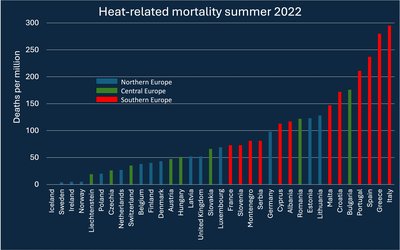
By Wilfried ten Brinke
This longread is based on a large number of scientific sources assembled by the ClimateChangePost. Check out the health pages on www.climatechangepost.com for more details.
Will an increase of the number of heat-related deaths in the summer balance a decrease of the number of cold-related deaths in the winter? Maybe not. The number of excess winter deaths may increase in the coming decades due to an increase in future winter temperature volatility and because of a growing and ageing population.
Most people die from cold-stress in warmest countries
Most European countries have between 5 and 30% higher death rates in winter than in summer. Winter‑related mortality in many European populations has declined since the 1950s. Cold days, cold nights and frost days have become rarer, but explain only a small part of this reduction: improved home heating, better general health and improved prevention and treatment of winter infections have played a more significant role.
Remarkably, in Europe the mortality in cold winters is generally higher in countries with relative mild winters than in countries with cold winters. The countries with the highest rates of “excess” winter mortality in Europe are Portugal and Spain, while excess winter mortality is lowest in the Scandinavian countries, although their winters are much colder. Scandinavians are well adapted (acclimatized) to cold temperatures and their houses meet higher standards of heating and insulation compared with Southern and Western Europe.
Taking stock: more heat-related versus less cold-related deaths
Less cold stress reduces winter mortality, more heat stress increases summer mortality. Will they balance one another?
One might expect that an increase of the number of heat-related deaths would go hand in hand with a decrease of the number of cold-related deaths, due to warmer winters. This line of reasoning may be too simple. According to scientific research this would hold for poorly insulated homes. However, the link between winter temperatures and excess winter deaths may no longer be as strong as before, due to better housing, improved health care, higher incomes and greater awareness of the risks of cold over the past few decades. Instead, the absolute number of excess winter deaths may increase in the coming decades due to an increase in future winter temperature volatility and because of a growing and ageing population.
The future balance between changes in summer and winter mortality under climate change is yet hard to project. This is partly due to the fact that the health impacts of climate change may be completely different for northern and southern, or eastern and western European countries. According to sources in the latest IPCC-report, the impacts on health of more frequent heat extremes probably greatly outweigh benefits of fewer cold days for Europe. Similar projections have been made for Germany and Sweden, for instance. In fact, this effect was already shown for Stockholm: a small decrease in extreme cold temperature mortality in 1980 - 2009 compared with 1900 - 1929 coincides with a much larger increase in extreme hot temperature mortality.
These results do not agree with those of others. For Finland, for instance, it was reasoned that mortality will probably decrease as the mean temperature increases: excess mortality is significantly higher in extremely cold temperatures than during periods of intense heat, and extremely cold temperatures are estimated to become less common. Also in the United Kingdom, the expected decrease of annual cold-related deaths (from about 80,000 in the 1990s to about 60,000 in the 2050s and 51,000 in the 2080s under scenarios of medium to high-end climate change) is far more than the expected increase of annual heat-related deaths (from about 800 in the 1990s to about 2800 in the 2050s and about 3500 in the 2080s under the same scenarios of climate change).
Mortality in winters may increase again, despite global warming
Who’s right, who’s wrong? Future will tell. Converting milder winters and hotter summers in changes in mortality is often based on statistical links between cold winter and hot summer temperatures and excess winter and summer deaths from the past. In London both cold-related mortality in the winter and heat-related mortality in the summer diminished progressively during the 20th century, despite an aging population. This trend is likely to reflect improvements in social, environmental, behavioral, and health-care factors and has implications for the assessment of future burdens of heat and cold mortality.
Data from the past, however, cannot be used that easily to predict the future. A recent analysis of data over the past 60 years for England and Wales has shown that the link between winter temperatures and excess winter deaths may no longer be as strong as before and that how harsh a winter is no longer predicts how many excess winter deaths there will be. The researchers who carried out this analysis state that many of the papers that concluded that climate change would lead to fewer excess winter deaths are not recent and rely on relatively old data. According to them the correlation between the number of cold winter days per year and excess winter deaths, which was strong until the mid 1970s, no longer exists. In fact, they say, the absolute number of excess winter deaths may increase in the coming decades due to an increase in future winter temperature volatility and because of a growing and ageing population.
Source: www.climatechangepost.com








